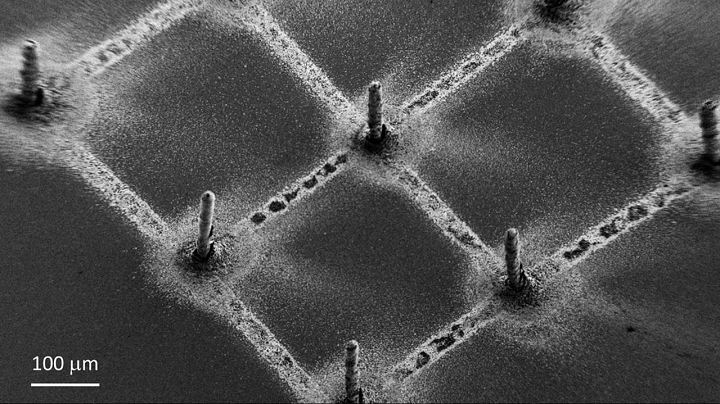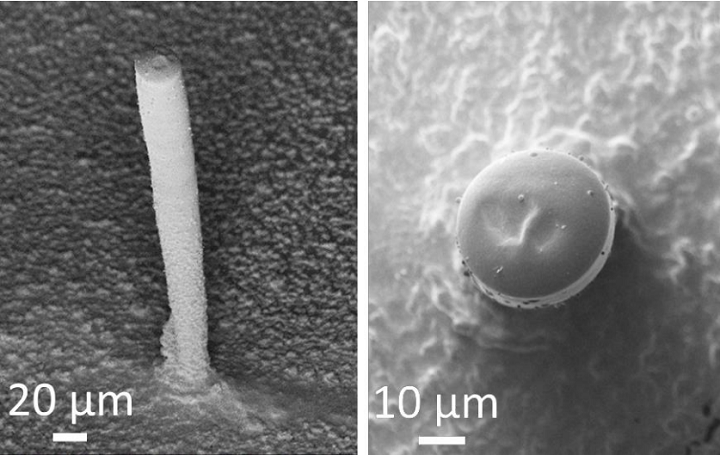Researchers Use Aerosol Jet 3D Printing to Make Efficient X-Ray Detectors
Wilhelm Röntgen discovered X-rays in 1895, and, to this day, they remain a fundamental tool in medical imaging, though a lot of progress has obviously been made since then. Medical uses for X-rays include radiographs, radiotherapy for cancer, fluoroscopy, and computer tomography, or CT, which takes several X-ray scans from various angles and then combines them all to create virtual, cross-sectional “slices” of the body. The technology is used in low-exposure conditions, so it needs high-resolution detectors, at a reasonable price, that are able to efficiently operate at “low photon flux,” meaning a smaller amount of photons colliding with the detector and determining how many electrons it generates at a given point.
A team of researchers from Switzerland’s Ecole Polytechnique Fédérale de Lausanne (EPFL) used aerosol jet 3D printing to create X-ray detectors that are extremely sensitive, and therefore safer, more efficient, and less costly. They discuss their work in a paper, “Ultrasensitive 3D Aerosol-Jet-Printed Perovskite X-ray Photodetector,” published in ACS Nano.
The abstract states, “Recently, hybrid halide perovskite CH3NH3PbI3 (MAPbI3) has attracted considerable attention due to its advantageous optoelectronic properties and low fabrication costs. The presence of heavy atoms, providing a high scattering cross-section for photons, makes this material a perfect candidate for X-ray detection. Despite the already-successful demonstrations of efficiency in detection, its integration into standard microelectronics fabrication processes is still pending.”

Example of the deposited perovskite pillars, defining a pixel for the creation of an image. Photo credit: László Forró, EPFL.
László Forró with the school’s Laboratory of Physics of Complex Matter (LPMC) led the team, which utilized aerosol jetting to develop a method for creating these more efficient X-ray detectors using graphene and perovskites; in case you didn’t know, because I sure didn’t, perovskites are materials made of organic compounds that are bound to a metal. Both of these materials of easy to synthesize, and are often used in such applications as lasers, solar cells, and photodetectors.
Aerosol jet 3D printing is used to 3D print electronic components such as antennas, capacitors, resistors, sensors, and thin-film transistors, among others. The technology can even be used to 3D print electronics onto a substrate, such as a cell phone, and it’s this ability in which the EPFL researchers were most interested.

Schematic representation of the Aerosol Jet Printing method developed in this study. The agitated methylammonium lead iodide perovskite solution is focused to a predefined position at the nozzle by the nitrogen (N2). The particularity of the material is that formed nanocrystals in flight do not spread out on the graphene substrate, allowing the creation of 3D architectures. Photo credit: Glushkova et al, ACS Nano.
“Here, we demonstrate a promising method for building X-ray detector units by 3D aerosol jet printing with a record sensitivity of 2.2 × 108 μC Gyair–1 cm–2 when detecting 8 keV photons at dose rates below 1 μGy/s (detection limit 0.12 μGy/s), a 4-fold improvement on the best-in-class devices. An introduction of MAPbI3-based detection into medical imaging would significantly reduce health hazards related to the strongly ionizing X-rays’ photons,” the team wrote.
Utilizing the aerosol jet system at the Swiss non-profit research and technology organization CSEM, the team 3D printed perovskite layers onto a graphene substrate. Basically, the perovskite is used as both the electron discharger and photon detector, and the graphene amplifies the outgoing electrical signal to make an efficient X-ray detector, which can then be integrated into standard microelectronics in order to boost the performance of medical imaging systems.
The team picked the methylammonium lead iodide perovskite (MAPbI3) due to its optoelectronic properties.
Endre Horváth, the research team’s chemist, explained, “This perovskite has heavy atoms, which provide a high scattering cross-section for photons, and makes this material a perfect candidate for X-ray detection.”
Using their newly developed method, the researchers report that the results they achieved were “stunning.” The X-ray detectors they made had excellent sensitivity, and “a four-fold improvement on the best-in-class medical imaging devices.” Additionally, it’s pretty easy to form images using the perovskite-graphene detector; pair these advantages with cost-effectiveness and improved safety, and you’ve got a winner.
“By using photovoltaic perovskites with graphene, the response to X-rays has increased tremendously. This means that if we would use these modules in X-ray imaging, the required X-ray dose for forming an image could be decreased by more than a thousand times, decreasing the health hazard of this high-energy ionizing radiation to humans,” Forró concluded.
(Sources: Tech Explorist, EPFL)
Subscribe to Our Email Newsletter
Stay up-to-date on all the latest news from the 3D printing industry and receive information and offers from third party vendors.
Print Services
You May Also Like
RAPID 2025: Stratasys & trinckle Announce Strategic Software Partnership
News continues to flood in from last week’s RAPID+TCT 2025, including a new partnership between AM market leader Stratasys and Berlin-based software company trinckle. By automating important steps in fixture...
RAPID TCT 2025: Spring in the Paris of the Midwest
I’m going to go out on a limb here and say that whomever coined the phrase Detroit: Paris of the Midwest, had not spent a lot of time in Paris...
3D Printing Financials: 3D Systems Looks to Bounce Back in 2025
After a challenging year for the industry, 3D Systems (NYSE: DDD) ended 2024 with results pointing to a reset, laying the groundwork for future profitability. The company didn’t post strong...
Printing Money Episode 27: Q4 2024 Public 3D Printing Earnings Review with Troy Jensen, Cantor Fitzgerald
Q2 2025 has already begun, but public markets reporting has only just finished with Q4 2024. To tie a bow on Q4 2024, we are thankful to have Troy Jensen...


























